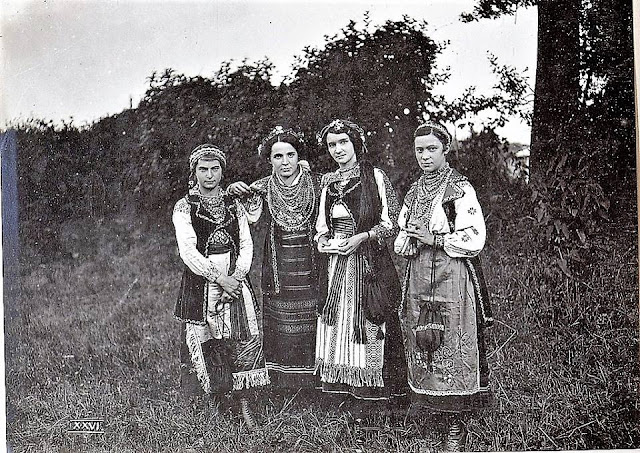Hello All,
Today I would like to talk about a type of Ukrainian costume which was invented in the early 20th cent. After the Austrian Empire was broken up and the State of Poland restored, much of Western Ukraine found itself included, and under the pressure of Polish rule, a resurgence of National awareness began. Many middle class and city people wanted to express their Ukrainian identity, but were not willing to wear peasant costume, and so invented one for themselves. This is similar the how the Russian Town Costume began.
The above image is from the village of Smykiwtsi outside Ternopil', and is a typical example.
The native embroidery was expanded and used more extensively, and more colors were added, possibly because DMC was becoming more widely available.
Some would say that this is not a traditional Ukrainian folk costume, but it has roots in our peasant costume, and has become a tradition in its own right, it depends on how one defines 'traditional'. In the period between the world wars, this outfit became very popular. This costume was found throughout Halychyna in Poland, except where local traditions were strong. From southern Volyn' to parts of Boiko land and from Peremyshl to Ternopil'.
These photos are from the Boiko village of Bandriv, or Bandrow, which today lies in Poland.
The traditional womens' shirts in this area had a wide stripe of embroidery across the shoulders, on the inset, or ustawka. In the Halychyna town costume, it was common to multiply the embroidery. Vertical or diagonal stripes were often added to the sleeves, inspired by the shirts of Podillia, Pokuttia and Bukovyna. At other times, the main design was repeated vertically on the sleeves. Both are visible in the image above. At other times the same horizontal design, or others of similar width were repeated at intervals down the sleeve. All of these are visible in the photos above. In this costume, the sleeve was not gathered into the shoulder inset, but was the same width. Here is another example from the village of Lybokhora in Skoliw district. Here we see a band of embroidery on the ustawka, another on the upper sleeve, and two more located lower down on the sleeve. Often there would be a relatively wide band of embroidery on the front as well.
The apron in this area was traditionally made of two fields of cloth, with a decorative joining stitch down the center, and a band of embroidery near the hem. This was replaced by a narrow apron of one field of cloth. Multiple horizontal rows of embroidery were worked on these aprons. They were not hemmed, but self fringed, the fringe being tied into knots to form tassels, and later divided into bundles worked in macrame. If you take a look at the photo at the head of the article, you can see that the aprons have sewn on store bought fringe.
Skirts were made of bought cloth, often of challis floral print, and were relatively narrow, echoing the narrow silhouettes of the Poltava and Podillia type costumes.
New designs were often created, usually with the idea that more was better.
The most common embroidery technique used was cross stitch, and a highly polychrome geometric style of embroidery developed. The origins of these designs is not entirely clear, but they became a distinctive style in their own right.
Often inspiration was taken from Hutsul nyzynka designs, and they were altered to be done in cross stitch. They often developed further, and so were born designs that could not possibly be done in nyzynka. A couple examples from my personal collection.
New designs were often created, usually with the idea that more was better.
In this example we see modern floral designs, possibly from Brokar or western sources, with added colors, and repeated down the length of the sleeve. Note that western style lapels have been added to the vest.
Red and black floral designs were also borrowed from the Brokar designs then popular in eastern Ukraine.
The aprons were usually made of white linen, but colored cloth was sometimes embroidered with waste canvas.
Often the embroidery on the sleeves was worked vertically. Notice the contemporary hairstyles. Woman in the towns often started to leave their hair uncovered.
Here are some examples of the aprons
Two types of vest were worn with this outfit, the first was the gorset, a waist length vest that was laced closed in front. It usually had lappets around the waist, but sometimes a peplum. This is visible in some of the images above, and this one, from the village of Brodky near Mikolaiv.
But many people thought that it was too Polish. This type of long open vest shown below was more common. The origin of this garment is unkown. It vaguely resembles the kersetka of eastern Ukraine, but does not have the full skirt, being relatively narrow. It also does not overlap in front, but is designed to show off the embroidery on the front of the blouse. It may have lapels, obviously copied from western costume. It was often lavishly embroidered with satin stitch and/or beadwork.
Such vests were often made of black velvet.
Here are a few examples.
Rounded corners, like in this example, are often found in invented and stage costumes for some reason. I have never seen them in authentic folk outfits.
Men's shirts began to be sewn with a modern cut, with a stand up or turn down collar, and the main focus for embroidery became the front of the shirt, the embroidery often made very wide.
Roman K
email: rkozakand@aol.com







































































